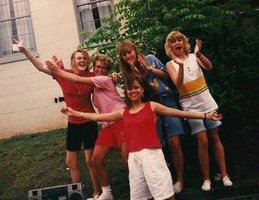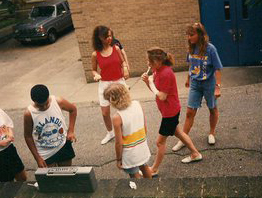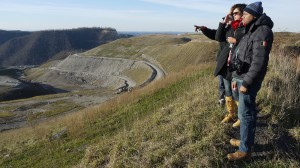It is foolish to say we are destroying the earth ~ cause everything we’re doing destroys us first
– KRS ONE, The Gospel of Hip Hop

Crystal and the 9th grade crew, with boom box
I was in the 9th grade when I first heard “Self Destruction” produced by KRS-One and D-Nice, members of the iconic hip hop group Boogie Down Productions. The charity single became the anthem of the Stop the Violence Movement, started in response to violence in the hip hop and African American communities.
“Self-Destruction” featured an all-star line-up: Stetsasonic with Delite, Daddy-O, Wise & Frukwan, Kool Moe Dee, MC Lyte, Doug E. Fresh, Just-Ice, Heavy D, Public Enemy with Chuck D & Flavor Flav. It moved an American generation to think about social activism, including me.
My activism started by just listening and playing hip hop music. I grew up in a small West Virginia town — hip hop wasn’t easily accessible. I still remember the taunting that came from listening to this new music. It was almost an act of civil disobedience to play hip hop loud. It was defiant in my town.

Crystal (red shirt, white shorts) and the crew engaged in musical activism
During this time, I often bought bootlegs (if that’s what you call them) of the New York City hip hop station Hot 97. These tapes were sold by “somebody’s” cousin who was coming in from NYC. VHS tapes of Black Entertainment Television’s (BET) RAP City, recorded in the next town over (Dunbar, WV) where BET was carried on the cable station, were regularly bought and sold too.
That must sound strange — that we would pay for a tape of a free radio station and a cable show, but we were thirsty for hip hop culture — even though we didn’t know it was a culture then. It was the music we liked, the music that gave us a collective sense of being, American — not just this “other” America stuck in West Virginia, but a part of a bigger America, an America that was indeed hip hop and us.
An entire generation in America — under 50, black, white, red, brown, orange (tanning bed humans) transgendered, men, women, gay, straight, educated, undereducated, democrat, republican, libertarian, voters and consumers — were informed, shaped and are still loyal to the hip hop artists of their youth.
Today, at any stop light across West Virginia, you’re likely to hear Jay-Z blasting from a pickup truck emblazoned with a Friends of Coal sticker. But in the 90s it was a different day and time for hip hop. Its (hip hop) innocence in the world was just like mine. I came of age with hip hop, my roots and identity are in hip hop, and that includes the sense of activism it asked me to think about and embody.
In West Virginia today, nobody has to pay for Hot 97 tapes — I’m not sure anybody has a tape player and you can stream it live over the internet. VHS tapes are today’s YouTube. Social media allows us to join hip hop culture – in its past and present in seconds.
We know today that hip hop has the power to carry messages around the world — this is evident in its ability to promote and sell brands — yet, there are few examples of hip hop embracing a cause and the positivity of the Stop the Violence Movement with the same effectiveness.
Figuring out how to increase effectiveness in dealing with issues of violence has been part of my own journey in activism. While hip hop inspired my activism, being both a person of color and West Virginian inspired my actions. Of course, I was drawn to environmental issues, as the coal industry dominated our landscape and culture here. There’s violence there, too, in the way the industry treats workers, communities and the water and land. Violence that must be stopped.
I’ve been thinking a lot lately how the intersection of hip hop culture and environmental activism can help stop the violence and give voice to issues. In 2013, I was a panelist at the Redeem The Dream, an Urban League Conference, where I shared my role as a social entrepreneur on the Burger King sponsored panel “Making the Leap from Corporate America to Entrepreneurship.” There, I shared my ambitions to bring Black adventure tourists to West Virginia – but nobody, will want to visit West Virginia if its beauty is lost. This had me thinking about the absence of environmental and energy dialogue at the Urban League conference. I thought: Aren’t there jobs in environmental and energy field for Blacks? Why are there no Black leaders in national environmental organizations? Who is talking about environmental and energy issues in hip hop — don’t we all need the same earth?
At the conference party, I noticed who was on the 1 and 2s, keeping the people smiling. It was DJ D-Nice — Derrick Jones, that member of Boogie Down Productions who produced “Self Destruction,” which raised half a million dollars for the National Urban League in 1989. Then, I had an idea.
I was familiar Jones’ passion for humanitarian causes, not only for his role in my childhood memories of hip hop, but how Jones has turned his creative talents to photography. He uses his Instagram account, with more than 48,000 followers to share everyday heroes and give homeless people a face.
So while listening to Jones keeping the party hot, I started sketching out the idea of inviting him to West Virginia. To my surprise, he accepted the invitation and traveled to West Virginia, where he photographed mountaintop removal coal mining with OVEC, a local environmental justice group. I served on OVEC’s board from 2009 to 2013.
What is mountaintop removal? Well, Jones didn’t know the answer to that either — not really. He got sort of a crash course in West Virginia eco-disasters ranging from deep-shale natural gas fracking to mountaintop removal (MTR) coal mining upon his arrival.
MTR is a kind of insane coal mining method — as insane as black on black crime is and was. The same thought applies — Why do we kill our own people? – that’s what MTR does.
Let me explain.
To get to thin seams of coal underlying the mountains of Central Appalachia, coal companies first bulldoze the mountains’ forests, which are some of the most biologically diverse woodlands on Earth. Trees, bushes, herbs, even the topsoil are all obliterated, and then the underlying rock is blasted away, in explosions ten to 100 times more powerful than the bomb blast that tore apart the Oklahoma City federal building.
Next, huge draglines — about 20 stories tall — and gargantuan dump trucks remove the rubble to get to thin, multiple layers of low-sulfur coal. The draglines cost about $100 million and for profits’ sake, must stay in continual operation. These machines scalp up to 600 feet, sometimes more, off the tops of mountains. In a process called valley fill, the “overburden” is dumped into valleys and streams, in piles that can be miles long and hundreds of feet high.
Toxic dust rises up from these huge mines, so big they are visible to astronauts, making people in nearby communities sick, causing birth defects, cancer and premature death. Many people are forced to sell their ancestral home places at greatly devalued prices. Entire communities are driven to extinction. The massive alteration of the landscape makes flooding in the valleys more likely and the runoff from these mines increases pollution to the detriment of wildlife and, ultimately, humans. Some of these sites — like the Hobet Mine are as big as Manhattan. Manhattan!
It’s a lot to understand. I wrote a poem to try to explain — it’s called Boom Boom. Some folks find the metaphor helpful — it’s about a stripper and a strip mine. Strip-mine is what a mountaintop removal site is also called. I encourage you to take a look.

Jones surveys MTR on Kayford Mountain with Crystal Good and (arm visible) Tuesday Taylor.
Photo by Vivian Stockman
In mid-November of 2013, Jones arrived in West Virginia to wittness and photograph some of the MTR sites firsthand. We (myself, OVEC staff Vivian Stockman and poet Tuesday Taylor) took him up for a ground tour of Kayford Mountain, where we met with Keeper of the Mountain’s member Junior Walk. The next morning, Jones, Stockman and I took an aerial tour of mountaintop removal sites courtesy of SouthWings. He found the whole tour deeply disturbing.
Jones has no foresight into how applicable the Stop the Violence movement would be to the environmental struggles of today, mostly because environmental questions and the absence of “green” jobs for people of color are not something that hip hop has traditionally challenged, understood, or talked about not then, and not now.
On his visit to West Virginia, Jones learned there is a desperate need to STOP THE VIOLENCE against earth, and thus stop the environmental violence and racism against poor and colored people. He hopes his photographs will lead to dialogue and investigation about mountaintop removal in West Virginia and that people will follow coal to the inner cities.
Because there is indeed a direct connection between the violence visited upon rural Central Appalachia and the inner cities.
In November of 2012, the NAACP released a report, Coal Blooded: Putting Profits Before People, which explores how people of color suffer disproportionately from polluted air and water as a direct result from the combustion of coal — including coal that is mined in West Virginia.
The Hip Hop Caucus is lifting up this dialogue, too, with its platform toward comprehensive climate legislation to end to the fossil fuel economy.
Jones’ visit to West Virginia can only help build this conversation. He said, “It was important for me to see and understand what is happening in West Virginia and learn more about environmental issues. I hope these photographs will help in some small way expand the dialogue.”
25 years after Jones and colleagues produced “Self Destruction,” the song still echoes: Self Destruction, we are headed for self-destruction. That is, unless we step up and speak out for the earth — using photography, hip hop, poetry, dance or whatever art form moves you.
Sign up for OVEC action alerts here. Exlpore the OVEC website here.
More websites to explore:
Hip Hop Caucus
NAACP Climate Justice Initiative
Keeper of the Mountains
If you like, follow me follow me — although I ramble — on Instagram and Facebook.
Also, be sure to check out:
Grandmaster Flash & Furious Five: “The Message”
dead prez’s album “Pulse of the People”
Mos Def: “New World Water”









